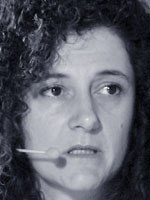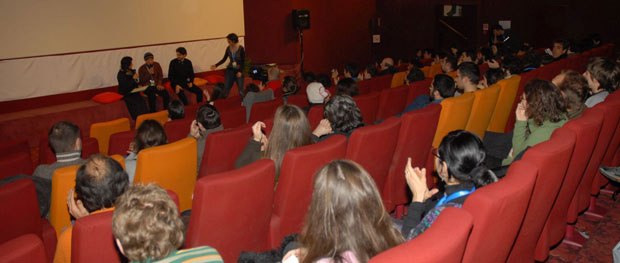Marco Consoli reports back from the Future Film Festival, where he experienced some tasty digital delights, both large and small, from around the world.

Bologna, Town of Students, Tortellini and Cartoons
Bologna, a town comprised of 370,000 inhabitants in the northern part of Italy, is well known because it has the oldest university in the world, established in 1088, two famous towers from the XII Century, called Garisenda and Asinelli, old churches and ancient palaces and because you can try some of the famous tortellini, the pasta stuffed with ham, meat and parmesan cheese, and usually cooked in hot beef bouillon. But for the last nine years, Bologna is well known also because every year in January fans of cartoons and blockbusters throughout Italy gather for the Future Film Festival, dedicated to animation and visual effects and directed by Giulietta Fara and Oscar Cosulich. This year we were treated to unusually hot weather, a quasi-spring, due, no doubt, to the change in climate that worries Al Gore as well as many scientists around the world. The program contained several previews, such as Arthur and the Minimoys (aka Arthur and the Invisibles), Charlotte's Web and various other animated films coming from Japan and Europe; then there were a number of open meetings with professionals from the animation and vfx industry, and some noteworthy retrospective screenings.

Grand Opening and Other Previews
The opening of the festival was celebrated with a special event: a meeting with Silvia Pompei, character animator at Film Roman, who showed the delighted audience some glimpses of the long awaited The Simpsons Movie, (including a colorful shot of a crowd Springfield citizens that is very angry with Homer, as usual). "We are still working on animation, and it's a continuous work in progress, because writers change the story every week," said Pompei, while showing an interesting documentary with interviews conducted with the director David Silverman and other artists at Film Roman. She couldn't reveal anything about the plot, but explained the main differences between the TV series and the movie: "The movie will be in CinemaScope ratio, so this means a great opportunity for animators to fill this new space with characters and jokes, but it represents also a challenge in storytelling, because in the series gags often play on the sudden reveal of what's off-screen, which is very hard to choreograph within a wider screen. So we used the trick of using the upper and lower part of the screen and also the third dimension, meaning that often something is hidden behind objects. The movie will present also a richer and wider color palette and also shadows on characters, and despite being presented as a 2D movie, it will use a lot of 3D animation, very useful for artists, but invisible to moviegoers."
Apart from the screening of Arthur and the Minimoys by Luc Besson, followed by an interesting meeting with French visual effects supervisor Geoffrey Niquet, the audience seemed to like other previews. Two movies demonstrated the richness of Danish animation: the drama Princess by Anders Morgenthaler is an adult story about a man on a search for a vengeance against the owner of a porn movie company that caused the death of his sister and the confining of his niece to an orphanage. It's a touching movie that showed the potential of animation to explore genres other than animation, and contained an interesting mix of animation, used here for dramatic flashbacks. Then, The Ugly Duckling and Me by Michael Hegner and Karsten Kiilerich, updated the well known Hans Christian Andersen fairytale, with the story of an ugly duckling adopted by a greedy mouse that wants to exploit him as a freak at carnival shows. A fresh and humorous comedy, demonstrating, as Pixar has taught us, that story and characters are far most important than the quality of graphics.
It was also very entertaining to watch The Girl Who Leapt Through Time, the new Japanese movie directed by Mamoru Hosoda from Mad House. It tells the story of a teenage girl that travels through time, mainly going back in an attempt to fix events and mistakes and causing lots of trouble. It's a hilarious movie, with well crafted characters and a life lesson about the consequences of our choices. Other well received previews were Renaissance by Christian Volckman, with its outstanding black-and-white imagery made with the rotoscoping of real actors, and Astérix et les Vikings, by Jesper Møller and Stefan Fjeldmark, with the amusing adventures in Scandinavia of the famous duo, Astérix and Obélix, created by Goscinny and Uderzo. This is one of those rare series enriched by the use of 3D animation, in addition to traditional 2D.
From Quino to Iranian and Chinese Animation
Among the many guests honored at the festival was Quino, the 74-year-old Argentinian maestro of satirical strips and creator of Mafalda. He talked in a overcrowded theater about his work, showing some very rare animated shorts from the '80s, made in collaboration with Juan Padrón, and inspired by his strips. Then the festival offered an interesting showcase of animation from China and Iran, of which we know almost everything about their atomic strategies and foreign policy, but precious little about their artists. There were screenings where it was possible to admire the incredibly good use of different animation techniques: shorts made with sand, paint, aquarelles and other materials, such as a funny yet serious Iranian short about tyranny, made with puppets of mice, which reminded one of the masterpiece Maus by Art Spiegelman. In addition to homages to such well known animators as Paul Driessen and Norman McLaren, whose works were shown during the four-day festival, it was very interesting to watch screenings of the cartoons of the Milanese studio Gamma Film, which, between the '50s and '70s, created dozens of cartoons and characters for the Carosello, the special program of ads that ran on TV after the news. The show and meeting with Gamma Film founders gave a powerful insight into the connection between animation and advertising, very convenient for artists 50 or even 30 years ago, because of the direct link with brand owners, and the great opportunity for artists to create funny shorts while exploiting the brands. A relationship that changed throughout the years, as Gino Gavioli said, "when advertising companies, with their stubborn and not so smart accountants, arrived into the market, and started to ruin the creative job with marketing plans and strategies."

Behind the Animated Lines
A large part of the festival in Bologna is devoted to world of visual effects, videogames and digital techniques. So every year the meetings with some of the most important artists and professionals, coming mainly from Hollywood, are very well received by the audience. A very lively debate occurred, however, during a discussion of the making of Pirates of the Caribbean: Dead Man's Chest by Geoff Campbell, digital model supervisor at Industrial Light & Magic. It's one thing to use modern technology to make original CG characters, such as the tentacled Davy Jones, but what about the the possibility of using digital tools to cinematically rivive deceased movie stars? "I think that from the technological point of view, it's already possible," Campbell asserted, "and it's not even a [question] of money, because I don't think that reviving Bogart or Marilyn Monroe would cost more than creating Davy Jones. It will happen for sure, as well as digital technology [being used] to rejuvenate old actors: I know that some movie studios [have already asked ILM for such effects]."
Another very interesting talk occurred with Fiona Kenshole, a cheerful English woman working with Laika Ent., the company that Nike owner Phil Knight purchased to produce animated movies, while at the same time providing a professional opportunity for his son, a very talented young animator. "Luckily," said Kenshole, "we now have more money than projects and we want to produce two movies a year, starting next year." After a screening of Moongirl, a very nice short, directed by Henry Selick, Kenshole discussed two upcoming projects for release in 2008. The first is Seleck's Coraline, a stop-motion gothic fairytale adapted from Neil Gaiman's novel. The second is the digital cartoon Here Be Monsters! adapted from the illustrated debut novel by Alan Snow, whose rights were bought by Laika last year at the International Book Fair in Bologna, after a bidding war with DreamWorks and other studios. The good news for the professionals struggling to emerge in the industry is that Laika has a lot of money to invest for the next 10 years: "We want to bring on screen mainly adaptations of literature for kids, and we are looking everywhere for good stories," assured Kenshole. "But they must not be necessarily based on books, so if there are writers or animators that have a good story, they can contact our offices."
Unable to view the making of Flushed Away, due to the absence of Aardman Animation artists, who were stranded at the airport in London due to a tornado, festival attendees were instead treated to a 20-minute preview of Nocturna, a cartoon by the Spanish company Filmax set for release in 2008. It's about a kid obsessed by the fear of darkness and accompanied in his adventure by a cat. A cartoon that producer Paco Rodriguez, another follower of the Pixar gospel, presented as an original story that is in 2D, despite its abandonment in America. "We are not scared to go [up] against 3D movies, because we bet mainly on a good plot, while lately Hollywood showed us too many similar movies, mainly stories of funny animals, set in the neighborhood, in the woods, in the zoo and in too many other placet."
The Darkness was also the title of a videogame inspired by the comic series of the same name, and main subject of the presentation by Swedish developer Starbreeze, which will publish it next spring: a gory third-person shooter mixing elements of the Mafia movies with horror and monsters. A very funny and rousing presentation was made by Greek-born artist Miltos Manetas, who showed his paintings and videos inspired by videogame worlds, such as "the sleeping Supermario" or "the dying Lara Croft," and then talked about "neen," a term that represent an undefined generation of visual artists, expressing their ideas mainly through animations and imagery on the Internet. This was a presentation that led to an interesting debate about the intellectual property of digital information and entertainment.
Marco Consoli is a freelance journalist who writes about movies, animation and videogames for Corriere della Sera, the prestigious Italian newspaper, and for magazines such as Ciak, Jack, L'Espresso. He's particularly passionate about visual effects, which he has written about for 10 years for numerous Italian magazines. He is 35 and lives between Milan and Venice. In his spare time, he updates his blog about upcoming movies.








